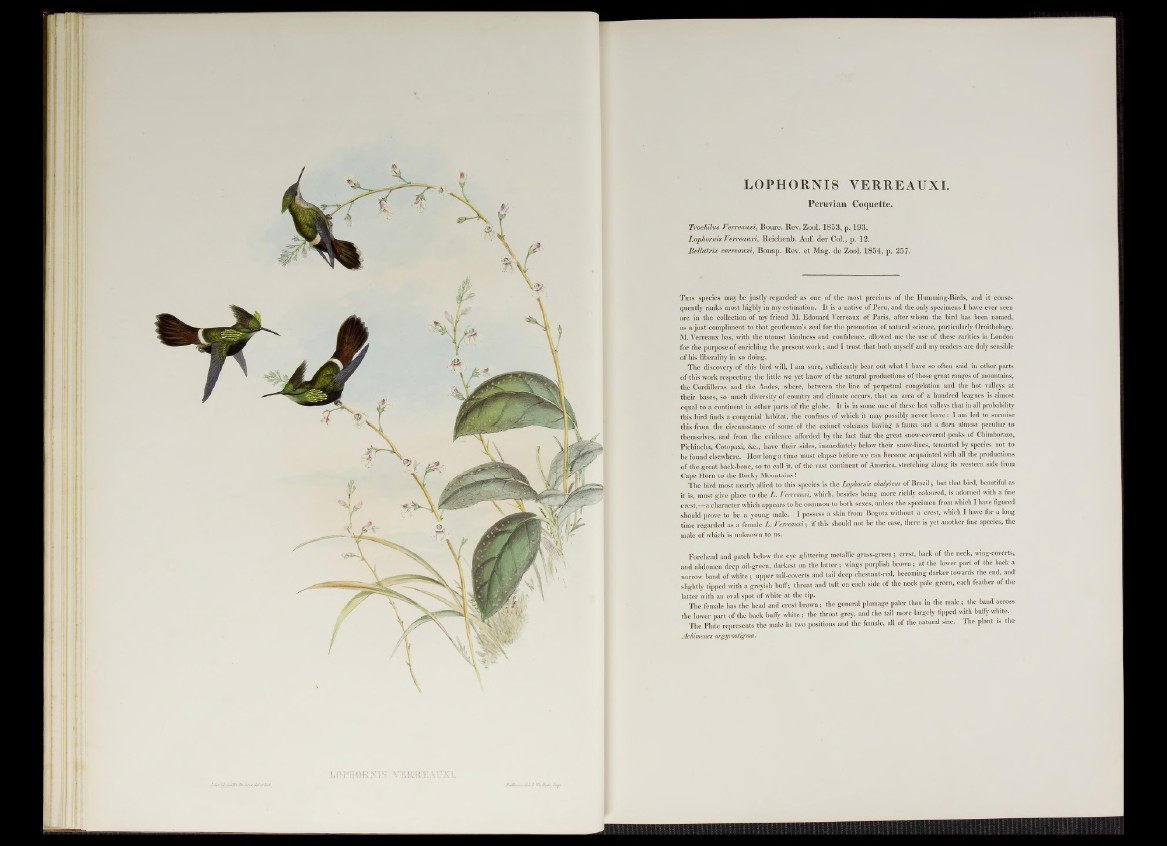
LOPHORNIS YERREAUXL
Peruvian Coquette.
Trochilus Verreauxi, Bourc. Rev. Zool. 1853, p. 193.
Lopliorim Verreauxi, Reiclienb. Auf. der Col., p. 12.
Bellatrix verreauoci, Bonap. Rev. et Mag. de Zool. 1854, p. 257.
T his species may be justly regarded* as one of the most precious of the Humming-Birds, and it consequently
ranks most highly in my estimation. It is a native of Peru, and the only specimens I have ever seen
are in the collection of my friend M. Edouard Verreaux of Paris, after whom the bird has been named,
as a just compliment to that gentleman’s zeal for the promotion of natural science, particularly Ornithology.
M. Verreaux has, with the utmost kindness and confidence, allowed me the use of these rarities in London
for the purpose of enriching the present work; and I trust that both myself and my readers are duly sensible
of his liberality in so doing.
The discovery of this bird will, I am sure, sufficiently bear out what I have so often said in other parts
of this work respecting the little we yet know of the natural productions of those great ranges of mountains,
the Cordilleras and the Andes, where, between the line of perpetual congelation and the hot valleys at
their bases, so much diversity of country and climate occurs, that an area of a hundred leagues is almost
equal to a continent in other parts of the globe. It is in some one of these hot valleys that in all probability
this bird finds a congenial habitat, the confines of which it may possibly never leave: I am led to surmise
this from the circumstance of some of the extinct volcanos having a fauna and a flora almost peculiar to
themselves, and from the evidence afforded by the fact that the great snow-covered peaks of Chimborazo,
Pichincha, Cotopaxi, &c., have their sides, immediately below their snow-lines, tenanted by species not to
be found elsewhere. How long a time must elapse before we can become acquainted with all the productions
of the great back-bone, so to call it, of the vast continent of America, stretching along its western side from
Cape Horn to the Rocky Mountains!
The bird most nearly allied to this species is the Lophornis chalybeus of Brazil; but that bird, beautiful as
it is, must give place to the L . Verreauxi, which, besides being more richly coloured, is adorned with a fine
crest, a character which appears to be common to both sexes, unless the specimen from which I have figured
should prove to be a young male. I possess a skin from Bogota without a crest, which I have for a long
time regarded as a female L . Verreauxi; if this should not be the case, there is yet another fine species, the
male of which is unknown to us.
Forehead and patch below the eye glittering metallic grass-green; crest, back of the neck, wing-coverts,
and abdomen deep oil-green, darkest on the latter; wings purplish brown ; at the lower part of the back a
narrow band of white ; upper tail-coverts and tail deep chestnut-red, becoming darker towards the end, and
slightly tipped with a greyish buff; throat and tuft on each side of the neck pale green, each feather of the
latter with an oval spot of white at the tip.
The female has the head and crest brown; the general plumage paler than in the male; the band across
the lower part of the back huffy white; the throat grey, and the tail more largely tipped with huffy white.
The Plate represents the male in two positions and the female, all of the natural size. The plant is the
Achimenes argyrostigma.